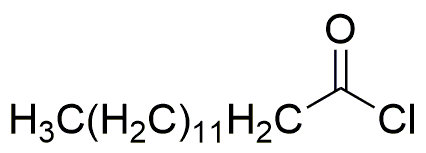Myristoyl chloride is widely utilized in research focused on:
- Surfactant Production: It is used to create surfactants that lower surface tension, making it valuable in detergents and emulsifiers for the cosmetic and food industries.
- Pharmaceutical Synthesis: This compound plays a crucial role in synthesizing various pharmaceuticals, particularly in the development of lipid-based drug delivery systems, enhancing drug solubility and bioavailability.
- Polymer Chemistry: Myristoyl chloride is employed in the modification of polymers, improving their properties such as hydrophobicity and thermal stability, which is essential in the manufacturing of high-performance materials.
- Bioconjugation: It is used in bioconjugation processes to attach fatty acid chains to proteins, aiding in the development of targeted therapies and improving the pharmacokinetics of biologics.
- Flavor and Fragrance Industry: The compound is also utilized in synthesizing flavoring agents and fragrances, enhancing the sensory attributes of various consumer products.
General Information
Properties
Safety and Regulations
Applications
Myristoyl chloride is widely utilized in research focused on:
- Surfactant Production: It is used to create surfactants that lower surface tension, making it valuable in detergents and emulsifiers for the cosmetic and food industries.
- Pharmaceutical Synthesis: This compound plays a crucial role in synthesizing various pharmaceuticals, particularly in the development of lipid-based drug delivery systems, enhancing drug solubility and bioavailability.
- Polymer Chemistry: Myristoyl chloride is employed in the modification of polymers, improving their properties such as hydrophobicity and thermal stability, which is essential in the manufacturing of high-performance materials.
- Bioconjugation: It is used in bioconjugation processes to attach fatty acid chains to proteins, aiding in the development of targeted therapies and improving the pharmacokinetics of biologics.
- Flavor and Fragrance Industry: The compound is also utilized in synthesizing flavoring agents and fragrances, enhancing the sensory attributes of various consumer products.
Documents
Safety Data Sheets (SDS)
The SDS provides comprehensive safety information on handling, storage, and disposal of the product.
Product Specification (PS)
The PS provides a comprehensive breakdown of the product’s properties, including chemical composition, physical state, purity, and storage requirements. It also details acceptable quality ranges and the product's intended applications.
Certificates of Analysis (COA)
Search for Certificates of Analysis (COA) by entering the products Lot Number. Lot and Batch Numbers can be found on a product’s label following the words ‘Lot’ or ‘Batch’.
*Catalog Number
*Lot Number
Certificates Of Origin (COO)
This COO confirms the country where the product was manufactured, and also details the materials and components used in it and whether it is derived from natural, synthetic, or other specific sources. This certificate may be required for customs, trade, and regulatory compliance.
*Catalog Number
*Lot Number
Safety Data Sheets (SDS)
The SDS provides comprehensive safety information on handling, storage, and disposal of the product.
DownloadProduct Specification (PS)
The PS provides a comprehensive breakdown of the product’s properties, including chemical composition, physical state, purity, and storage requirements. It also details acceptable quality ranges and the product's intended applications.
DownloadCertificates of Analysis (COA)
Search for Certificates of Analysis (COA) by entering the products Lot Number. Lot and Batch Numbers can be found on a product’s label following the words ‘Lot’ or ‘Batch’.
*Catalog Number
*Lot Number
Certificates Of Origin (COO)
This COO confirms the country where the product was manufactured, and also details the materials and components used in it and whether it is derived from natural, synthetic, or other specific sources. This certificate may be required for customs, trade, and regulatory compliance.

